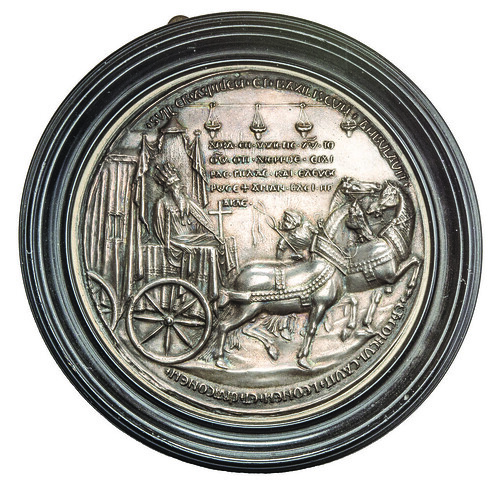
PREV ARTICLE
NEXT ARTICLE
FULL ISSUE
PREV FULL ISSUE
THE CLOISTERS ACQUIRES RARE LATE MEDIEVAL MEDAL
Amanda Stücklin of Morton & Eden Ltd. forwarded this press release at the request of David Tripp. Thanks! I hadn't seen this yet. A
very interesting medal, a copy of a lost medieval gold medal, has been acquired by The Cloisters. -Editor

Renaissance and Baroque medals from the collection of Sir Timothy Clifford, former director of the Scottish National Gallery, sold for £82,872 ($117,844) in a specialised sale of coins and medals at Morton & Eden in London (June 13, 2016). The highlight from Sir Timothy’s collection was an extremely rare French silver repoussé impression of a gold medal that formerly belonged to the important early renaissance collector Jean Duc de Berry (1340-1416). Depicting The Emperor Heraclius’s Return of the True Cross to Jerusalem the image became the inspiration for one of the illuminations in the famous book of hours known as the Belles Heures, itself commissioned by the Duc de Berry around 1409 and which is in the possession of The Cloisters Museum, part of the Metropolitan Museum of Art in New York which specialises in European medieval art. The Belles Heures has been described as one of the most celebrated manuscripts of the Middle Ages with fine illuminations attributed to the Limbourg brothers working in France in the early 15 th century. Estimated at up to £10,000 there was considerable interest shown and The Cloisters was able to acquire the medal for £21,600 ($30,715) against strong competition. Tom Eden, a director of Morton & Eden commented: “We were very pleased that this intriguing medal has found a new home in The Cloisters Museum as it very much complements the illuminated manuscript, the famous Belles Heures which already resides there. In many ways it is the ideal place for it”.
The Cloisters is a wonderful museum. I had the opportunity to visit many years ago. What a great numismatic acquisition, even if it is
"only a copy". Below is the desciption from the June 13, 2016 Morton & Eden sale catalog (which includes many illustrations of
stunning medals). The medal is lot 79. -Editor
School of Paris, Heraclius, Byzantine Emperor (610-641), The Return of the True Cross to Jerusalem, silver repoussé impression after the famous gold medal once in the possession of Jean, Duc de Berry (1340-1416), Heraclius in a covered triumphal car drawn by three horses, holding the True Cross; at the far side of the horses is a diminutive figure holding a whip and turning back towards the emperor; four lamps hang from a rail above them; Latin and Greek inscriptions above and below and in five lines across field, 102mm and 97mm excluding the outer rim (Jones, BMC, 5-7, especially 6 (e) for the silver double-sided repoussé piece in Paris illustrated by Babelon, La Médaille et Les Médailleurs, 1927, pl. III; Arm. II, 8, 6; Kress 525 = Pollard II, 598; Scher in Currency of Fame, pp. 32-37; Syson & Gordon, Pisanello, 20, 3.29), an extremely fine image, small French import mark of “cygne” near top edge and small section of outer order missing at 12 o’clock, extremely rare as a silver repoussé version, thought to be the earliest type of copy made after the no-longer-existing original in the Duc de Berry’s collection [Clifford lot 422, see also inside front cover illustration including frame] £5,000-10,000 The following note borrows in part from the footnote written in the 1996 Clifford sale catalogue. Of the two large gold medals of Constantine and Heraclius recorded in the inventory of the collections of Jean Duc de Berry, the Constantine medal was purchased from a Florentine merchant Antonio Mancini on 2 November 1402 and it has generally been assumed that the Heraclius medal came from the same source. It is from these two pieces or indeed copies of them that were commissioned by the Duke himself that all later versions seem to be derived. The earliest known versions consist of silver repoussé plates joined at their rims (for which see Jones, BMC, 1 and 6 – and the present piece). The solid casts mainly in bronze are thought to be later. The original of the Heraclius medal was in gold and was evidently in the French Royal cabinet, stolen and melted down in 1831 (see Jones, BMC, I, p. 26, note 15). The original medals probably date from 1400-1402 when Manuel II Palaeologus visited Paris since the legends on both medals show a knowledge of the Byzantine chancery formulae in use at the time. Also the features of the emperors on both medals do not conform to the traditional iconography of either Constantine or Heraclius, but rather show a marked similarity to Manuel II himself (for portraits of Manuel II see Bibliothèque Nationale, Paris, MS Suppl. Gr. 309; Herrin, J, Byzantium,The Surprising Life of a Medieval Empire, London, 2008, fig. 40). The medals were almost certainly produced in Paris, possibly with the Duke in mind as a purchaser. It may not be a coincidence that in March 1402 the Duke purchased two other “antique” medals of Augustus and Tiberius, from another Florentine merchant established in Paris, Michele de’ Pazzi. It has been suggested that they may be the work of the Parisian artist Michelet Saulmon, who is mentioned as the maker of a gold jewel in the Duke’s final inventory of 1416. To view the Morton & Eden catalogue, see: www.mortonandeden.com/pdfcats/80web.pdf For more information on The Cloisters, see:

Wayne Homren, Editor The Numismatic Bibliomania Society is a non-profit organization promoting numismatic literature. See our web site at coinbooks.org. To submit items for publication in The E-Sylum, write to the Editor at this address: whomren@gmail.com To subscribe go to: https://my.binhost.com/lists/listinfo/esylum All Rights Reserved. NBS Home Page Contact the NBS webmaster 
|